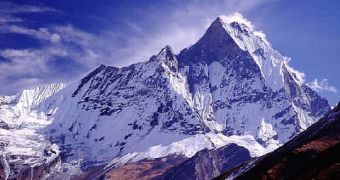Most people believe that pollution causes glaciers to thaw and eventually break down simply by making global average temperatures go up.
However, a new study carried out in the Himalayan Mountains shows that soot particles alone are responsible for the fact that the snow in this region is melting at an ever faster pace.
For those unaware, soot (a.k.a. “black carbon”) is basically made up of carbon particles which are left behind when a hydrocarbon is incompletely burnt.
This dust is released into the atmosphere by diesel engines, thermal power plants, and even forest fires, and the wind apparently carries it all the way to alpine regions.
Inter Press Service explains that, once it reaches these areas, soot tends to settle down, meaning that it is absorbed by the glaciers and snow patches it happens to come across.
Scientist Gian Pietro Verza from the Pyramid International Observatory below Mount Everest explains that this is precisely what is affecting Himalayan icy landscapes nowadays, causing them to melt faster than one might expect.
More precisely: because of the soot they now contain, the glaciers in the Himalayas are absorbing more sunlight, a phenomenon that can only accelerate their melting patters.
The same source informs us that Paolo Bonasoni, one other researcher who looked into this issue, makes a case of how “Although glacier melting is predominantly due to global temperature rise, the deposition of pollutant particles like black carbon can enhance this effect.”
Given the fact that this accelerated glacial melt is bound to negatively impact on the communities living in or close to Himalayan regions, it comes as no surprise that efforts are made to find ways of keeping soot from further building up in these regions.
Environmentalists argue that it is indeed possible to halt this unexpected and unwanted melting of the Himalayan glaciers, provided that highly industrialized countries agree to work together and improve on global air quality.

 14 DAY TRIAL //
14 DAY TRIAL //